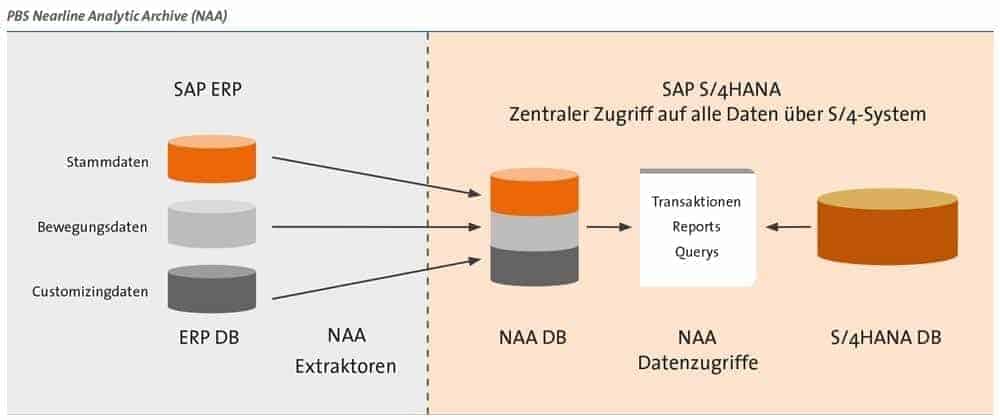Legacy ERP data available after S/4 changeover
![[shutterstock.com: 1625252818, WeAre]](https://e3mag.com/wp-content/uploads/2020/02/shutterstock_1625252818.jpg)

You can spin it any way you want: With every S/4 migration, you need to clarify which data from the legacy ERP ECC system should be made directly available in the SAP ERP technology successor - and which important legacy data needs to be kept in standby mode, so to speak, so that it can be accessed quickly and comprehensively when needed.
After all, in a greenfield approach, for example, i.e., a complete S/4 restart without historical SAP legacy and legacy data, as a rule only current open items, such as open postings including master data, are transferred to the new system environment as a matter of priority.
And even with a brownfield approach that takes into account certain SAP histories in a company, those histories and data will not be transferred in their entirety to the new S/4.

But how do you ensure that important legacy data is available and can be accessed after an S/4 migration? For example, existing pricing data/conditions, vendor invoices or posting documents in FI, variant configuration data in SD or maintenance specifications in the SAP maintenance module. Or how do you realize access to important legacy data during audits or revisions?
One of the key issues here is that in the SAP environment, it is not just the actual data that is involved, but also the associated SAP transactions that turn the data into business information.
This means, "That it's not practically enough to select data from an Any database used in conjunction with SAP Classic, extract it and import it into a dedicated SQL database on, say, a VM machine, and then access it with a query tool after an ERP shutdown"PBS manager Professor Detlev Steinbinder explains the situation.
Integration with the new S/4 application and the transactional, business view of the data for end users are missing. In addition, there is integration with the SAP authorization concept.
Tried and tested bundled anew
It is true that the problem could be solved by means of classic SAP data archiving, which is also the case with PBS solutions, especially for large SAP customers. However, medium-sized or mid-sized SAP users have often given this a wide berth up to now.
For reasons of cost or complexity; perhaps also because of a necessity that was not seen. Against this background, PBS has now developed a new complete solution called Nearline Analytic Archive (NAA), which according to the company will be available at the end of Q1/2020 and was presented to the SAP community at the DSAG Technology Days.
It can be used without classic SAP data archiving. In addition, NAA use does not require additional SAP license costs to be paid for its use.
The new PBS solution is based on proven PBS add-ons and includes new and further developments, geared to the requirements of medium-sized and small SAP existing customers.

As Steinbinder reports, "after an ECC S/4 changeover or after an ERP system shutdown, management and specialist departments can thus conveniently and easily access legacy data that is absolutely necessary for them and the associated known SAP transactions from all ERP modules.
And this directly from the new S/4. In addition to the transactions, NAA enables the generation of any queries with the inclusion of the SAP authorization concept. All legacy data, master and document data and the complete customizing of the legacy system can be viewed."
A foundation of the Nearline Analytical Archive solution is the PBS Nearline Analytical Infrastructure (NAI) framework. If you like, NAI is comparable to a kind of "side-car solution".
SAP Hana is known to run here and there as a side-car solution or add-on solution; in other words, as an additional solution connected to an SAP system with high system performance.
In terms of the functional principle, PBS NAA replicates the required ERP ECC data and stores it in a nearline database - also with the beneficial effect that a primary database of an SAP system used is not burdened.
Incidentally, it is irrelevant for NAI use whether Hana or an AnyDB is used as the primary database. NAA supports all current SAP ERP ECC system versions.
Different DBMS possible
A sophisticated NAA extraction component is used to extract company-specific data from an SAP system. This means that all important legacy data including transactions are determined or selected, replicated and transferred to the NAI database.
This process is either to be performed by the user or services are used for this purpose by an SAP partner, by a PBS partner or by PBS.
After that, the legacy system can be decommissioned. According to PBS, NAA fully complies with the tax and data protection requirements of the GoBD and DSGVO.
In addition, other NAI services can be used with NAA according to need (for example, External Data Services). Or analyses can also be performed directly in NAA.
And without negatively impacting an existing SAP system environment in terms of performance. "Various established DBMS solutions are supported as nearline databases, under diverse operating systems and service variants.
For example, the column-based database management system SAP IQ or IBM DB2 Blu with an upwardly open scaling. Furthermore, the use of Microsoft SQL Server is possible," concludes PBS manager Steinbinder.







